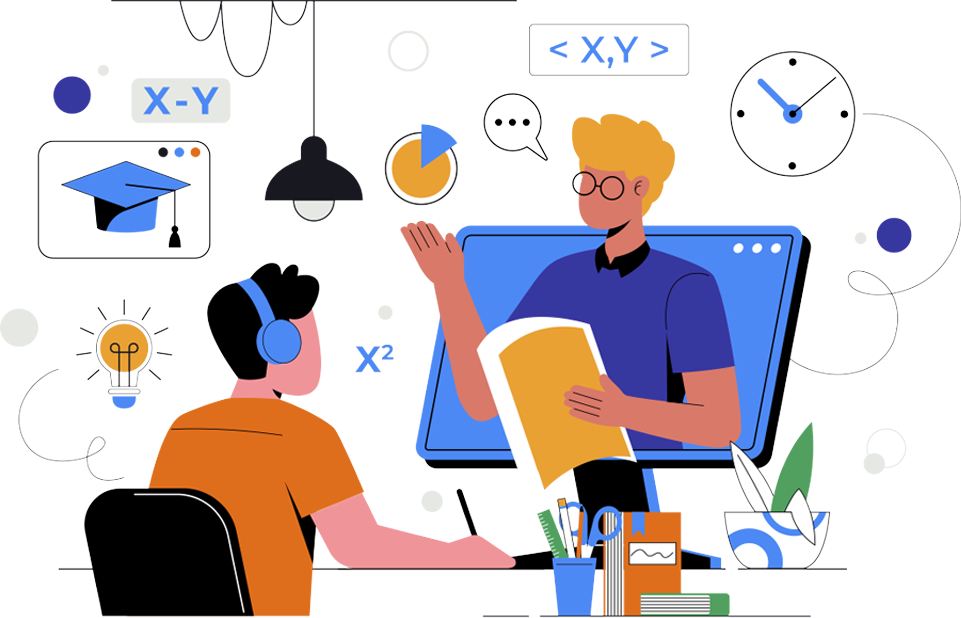
The Indian Educational Curriculum defines a well-structured and developed educational program that highlights the subjects, learning goals, and evaluation methods tailored to align with the academic requirements of understudies/students in India. It comprises a wide range of subjects that merely focus on a student's academic excellence but also take care of their holistic development.
The purpose of the Indian Curriculum is to impart knowledge that is not only restricted in textbooks but goes beyond it. It not only nurtures students who are academically proficient but also those who are socially mindful and culturally delicate. It focuses on preparing students for the challenges of this dynamic and cutting-edge world outside while inculcating a deep appreciation for India’s legacy and values.
In this blog about Indian Curriculum, we shall be talking about the complexities of it, how it aligns with instructive goal of the country, a comparison of it with British curriculum and so on. Let’s delve into the informations below:
The Indian curriculum is diverse with its two well-known education boards- The Central Board of Secondary Education (CBSE) and The Indian Certificate of Secondary Education (ICSE). Let’s have a look at both of them separately:
What is The Central Board of Secondary Education (CBSE)?
The Central Board of Secondary Education (CBSE):
It is a national education board in India which makes the whole curriculum and conducts examinations for secondary and higher secondary levels. It follows a unified approach, offering a standardised education system all over the nation.
The Indian Certificate of Secondary Education (ICSE):
ICSE is another education board in India which is known for its balanced and comprehensive curriculum. It is being
operated by the Council for the Indian School Examinations (CISCE). This board emphasises a profound study of subjects, covering a wide range of topics and a focus on English as the medium of instruction.
As the Indian education system has developed, there is a significant rise seen in curriculum development.as well. Talking about the ancient Gurukul system, prevalent around 1500 BCE, talks about personalised learning under the direction of a master or a guru. But as the time changed, the Mauryan and Gupta empires promoted a more organised approach to education, coming up with subjects like mathematics, astronomy, and literature.
Likewise, after independence, the education system aimed to address quality and accessibility. The Kothari Commission in 1964 proposed a holistic approach, focusing on a national curriculum framework. Later on in subsequent decades, it is seen that there have been efforts to balance traditional knowledge with modern subjects.
In recent times, the curriculum development has been influenced by technological advancements and global educational trends, encouraging a dynamic and overall learning environment. This historical course shows the diverse and evolving nature of the Indian education system.
The education system in India comprises different levels, each plays a significant building block in the academic journey. From pre-primary higher education, the whole structure is designed to offer an extensive opportunity for growth.
Pre-primary education focuses on the basic development of children who are from the 3 to 6 age group. It targets to nurture mental, social, and coordinated abilities through play-based learning.
Primary education focuses on the initial stage of formal schooling for the children between the age group of 6 to 14 years. It encompasses subjects like science, languages, mathematics, and social studies.
Secondary education is for the students from grades 9 to 12, focusing on a more specialised and top-to-bottom educational program. This phase builds groundwork for higher studies and vocational training as students at this stage prepare for board examinations.
Higher secondary education includes grades 11 and 12, too important for students who select a specific stream like commerce, arts, or science. With a successful accomplishment at this level opens the door to various undergraduate programs for the students
Tertiary and postgraduate studies at universities, colleges, and some other specialised institutions are the part of higher education. Students seek degrees in various subjects ranging from designing and medicine to humanities, business or other new & cutting edge professions.
Sometimes, regional proximity isn't the cause of inaccessibility in education. When financial limitations hinder a child's access to high-quality education, virtual education emerges as a remarkable alternative, surpassing underperforming schools. It serves as a significant upgrade in education quality, allowing remote education-providing schools to prioritize curriculum design and enhance educational standards. By operating with lower business costs, they can create smaller classrooms and foster enriched teacher-student interaction, enriching the learning exp
As covered earlier, virtual education isn't limited to online schools only. Almost all remote education or online learning is a part of virtual education. Therefore, many students who go to standard schools can use virtual
education to get a deeper understanding of what they learn in school.
Because of virtual education, we're no longer limited to the private tutors who live in your region. We can easily access virtual tutors from online tutoring platforms and can even use the services of online schools to arrange additional school hours for our child. With virtual learning, we can get quality education at our fingertips.
Another advantage of virtual education is that it allows people to continue learning regardless of their financial standing and schedules.
Learning is an ongoing process, but very few people have the time and the resources to take special classes for technical skills or soft skills once they finish their formal academic education.
Once one starts working, one might be too busy to enroll onself in a college for further learning and development. Skill-based education fosters and enhances the art of learning, allowing students to excel academically and in the modern world.
Students who familiarize themselves with online learning at a young age are far more open to virtual education once they start working.
Through the choice of enrolling your child in an online school or utilizing remote tutor services, you bestow upon them the invaluable gift of lifelong education. Studies have shown higher student enthusiasm for online learning which translates to openness towards virtual education later in life when the formal education is completed.
A student who graduates with some online learning experience is likely to take online courses, attend webinars, and self-educate with online resources in the future.
Educational systems worldwide vary significantly, and choosing the right board for your child is crucial. Here, we delve into key comparisons between Indian and international educational boards.
The Indian curriculum emphasises rote learning and a strong foundation in science and mathematics. Standardised examinations like the CBSE and ICSE play a pivotal role. In contrast, the American curriculum encourages critical thinking, creativity, and a broader range of subjects. It employs a GPA system, promotes extracurricular activities, and places significance on holistic development.
The Indian curriculum, rooted in theoretical knowledge, follows examination-oriented education with a focus on subjects like science, mathematics, and literature. On the other hand, the British curriculum, often implemented through the Cambridge system, emphasises practical skills, independent thinking, and a more comprehensive approach to subjects. Assessment is based on a combination of coursework and examinations, fostering a well-rounded education.

The Indian curriculum is distinguished by its emphasis on diversity and regional variations. It accommodates the rich cultural tapestry of the nation, incorporating multiple languages, histories, and traditions. This approach ensures a holistic education that reflects the country's multifaceted heritage, fostering a well-rounded understanding of India's diverse landscapes and communities.
The Indian Curriculum integrates both centralised and decentralised elements. While national boards provide a framework, individual states have the flexibility to adapt and enhance the curriculum. This combination ensures a standardised foundation across the country while allowing regional customization to cater to diverse educational needs.
Mathematics, Science, Social Studies, and Languages constitute the core subjects, forming the foundation of the curriculum and providing a well-rounded education.
The Indian curriculum emphasises a holistic education approach, integrating academic, co-curricular, and extracurricular activities. Board examinations, a pivotal aspect, assess students' understanding of diverse subjects. These exams play a crucial role in determining academic progress and college admissions, fostering a competitive yet comprehensive educational framework.
The Indian Curriculum emphasises science and technology, fostering a robust foundation in these fields. It integrates practical applications, critical thinking, and innovation to prepare students for the modern world. This focus aligns with India's commitment to technological advancement and scientific development, shaping well-rounded and future-ready individuals.
Recognizing India's multilingual landscape, the curriculum promotes language diversity, ensuring students can study in their mother tongue while also emphasising proficiency in English and Hindi.
The Indian curriculum emphasises holistic education with a blend of academic and extracurricular activities. Extracurriculars play a pivotal role, fostering creativity, teamwork, and leadership skills. Students engage in diverse pursuits like sports, arts, and community service, enhancing their overall development alongside academic excellence.
The Indian curriculum emphasises a holistic education approach, blending academics, arts, and physical activities. It integrates diverse subjects, fostering a well-rounded development. The examination system includes regular assessments, board exams, and a focus on conceptual understanding. Continuous evaluation encourages critical thinking and application of knowledge, preparing students for real-world challenges.
The Indian curriculum emphasises a comprehensive education system with a focus on academic excellence and holistic development. Grading and evaluation are integral, utilising a continuous assessment approach. The curriculum promotes a balance between theoretical knowledge and practical skills, fostering a well-rounded learning experience for students.
The Indian Curriculum emphasises inclusion and diversity by incorporating a broad range of cultural perspectives, languages, and educational approaches. It strives to provide equal opportunities for all students, fostering a learning environment that celebrates the rich tapestry of India's diverse heritage and promotes inclusivity in education.
Recognizing the importance of technology, the curriculum integrates digital learning tools, fostering digital literacy and preparing students for the evolving technological landscape.
The Indian curriculum emphasises teacher training and professional development as a key feature. Continuous learning programs ensure educators stay updated with effective teaching methodologies, fostering a dynamic educational environment. This commitment to professional growth enhances the overall quality of education, empowering teachers to deliver impactful and relevant lessons.

The Indian curriculum, renowned for its rich cultural
heritage and holistic approach to education, offers a
diverse and comprehensive learning experience. One
notable component is the National Institute of Open Schooling (NIOS), a flexible and inclusive educational
initiative. NIOS caters to diverse learning needs,
allowing students to pursue education at their own
pace andconvenience.
This approach accommodates various learning styles, making education accessible to a broader spectrum of individuals.
The reason to choose the Indian curriculum is that it emphasises a well-rounded development, integrating academic excellence with values, traditions, and practical skills.
The Indian curriculum, through its dynamic framework, equips students with not just academic knowledge but also instils a global perspective, preparing them for success in an increasingly interconnected world.
Amidst this educational landscape, 21K School emerges as a distinctive entity aligning with the Indian curriculum. This innovative institution incorporates the NIOS curriculum, emphasising adaptability and personalised learning. By leveraging NIOS's framework, they cater to individual learning styles, fostering a dynamic educational experience. This approach ensures that students receive a holistic education that goes beyond conventional boundaries, preparing them for a globally competitive future. The synergy between 21k School and the Indian curriculum, especially through NIOS, marks a significant stride towards accessible and quality education.
Undoubtedly, the educational journey in the Indian curriculum opens doors to holistic learning. But sometimes we get confused about choosing what is best for us as there are a number of options available? Among the different such choices, here we have the best three options that help you to choose the best for you.
21K School is a special online school where kids can learn, be creative, grow, and keep up with the times—all from their own homes. It started in 2020 and now has more than 7,500 students from 78 countries and 500+ teachers. We use our special online system for classes with live teachers. These classes are fun and led by teachers who speak English as their main language,and they have a lot of experience and qualifications needed by Cambridge and Edexcel.

In these virtual classes, we mix in cool videos and interactive activities to keep kids interested and make learning enjoyable. At 21K, each student can pick either Cambridge International or Edexcel, UK exams, accepted by over 2,000 universities and schools worldwide. The school uses project-based learning, focusing on solving problems, teamwork, and real-life experiences to prepare students for success in school and beyond.
Type: Co-education
Curriculum: Indian Curriculum, Cambridge International, and Edexcel
Language: English
Tuition Fee: $3,750 - $7,400 per year

Online education has undoubtedly revolutionised the learning landscape, bringing forth numerous advantages. However, amidst the benefits lie subtle challenges that require careful consideration and effective solutions. One such instance is exemplified by the 21K School, which aims to provide personalised, transparent, and affordable high-quality education through an innovative learning platform.
21K School, as a pioneer in online education, acknowledges these challenges and has crafted innovative solutions to address them. The proprietary learning platform at 21K School engages students with a rich repository of audio, video, and animated curriculum content sourced from globally renowned educators.
The school recognizes that mastering traditional subjects like the "3 R’s" is insufficient in the modern era. Therefore, they emphasise deeper learning through the practical application of knowledge to solve real-life issues.
Overemphasis on Technology:
Accessibility and Equity:

21K School acknowledges these criticisms and actively works towards mitigating them. The focus on personalised education aims to address individual learning needs, while transparency and affordability are key components to enhance accessibility. By incorporating a diverse range of content and emphasising real-world problem-solving, 21K School aims to provide a holistic education experience that goes beyond conventional criticisms of online learning.
In conclusion, while online education, represented by institutions like 21K School, offers transformative opportunities, acknowledging and effectively addressing subtle challenges and criticisms ensures a more robust and inclusive learning environment.
In recent years, the Indian education system has witnessed significant reforms and initiatives aimed at enhancing its overall quality and relevance. A notable initiative is the National Education Policy (NEP) 2020, which has ushered in an exemplary shift in the education scenario. However, there are other are a few points you might consider:
National Education Policy (NEP) 2020:
The NEP 2020 emphasises several key aspects, including a flexible and multidisciplinary approach to learning, an emphasis on foundational literacy and numeracy, and the integration of vocational education from an early age. The policy also advocates for the use of technology in education and aims to make education more inclusive and accessible.
Skill Development Initiatives:
Skill Development Cell has been entrusted with the responsibility to train youth by providing them skills through AICTE
approved Colleges/Registered facilitators with the objective for enhancing their Employment/ Self-Employment
opportunities.
It is the process of improving specific skills to be more efficient and effective when you perform a task. In the workplace, you’ll find three main types of skill development:
- Upskilling: Improving your skills in your current role
- Cross-skilling: Learn new skills for your current role
- Reskilling: Learning new skills so you can move to a new role .
Assessment and Examination Reforms:
Many education systems were moving towards a model of continuous assessment, where students are evaluated
throughout the academic year rather than relying solely on a high-stakes final exam.
This approach allows for a more comprehensive understanding of a student's progress. Further, the varied exam formats, such as open-book exams, project-based assessments, and oral exams, aimed to assess a broader range of skills and reduce the emphasis on memorization.
Digital Learning Initiatives:
Governments globally are embracing digital learning initiatives by integrating technology into curricula, fostering
e-learning environments, and addressing the digital divide.
Initiatives include providing devices and internet access to underserved communities, implementing online resources, and training educators in tech integration. These efforts aim to enhance educational accessibility and quality, ensuring that all students can benefit from the advantages of digital learning.
In the context of the Indian curriculum, future trends and outlooks emphasise a shift towards technology integration and skill development. The implementation of the National Education Policy (NEP) 2020 underscores a move towards holistic learning, focusing on critical thinking, creativity, and experiential knowledge. E-learning platforms and digital resources are expected to play an increasingly pivotal role in education delivery, promoting accessibility and flexibility.
Moreover, vocational and job-oriented education will likely gain prominence to align with the evolving needs of the job market. The emphasis on interdisciplinary studies and a learner-centric approach reflects a commitment to nurturing well-rounded individuals capable of adapting to the dynamic global landscape. Overall, the trajectory indicates a transformative approach to education in India, aligning with the demands of the 21st century.
In conclusion, the Indian educational curriculum, represented by boards like CBSE and ICSE, exhibits a rich tapestry of diversity and regional adaptability. Shaped by historical evolution and contemporary influences, it aims to foster holistic development, combining academic excellence with cultural sensitivity. The diverse types of curricula, from national frameworks to international programs like IB, contribute to a dynamic educational landscape.
Recent reforms and initiatives, such as the NEP 2020, underscore a commitment to flexibility, skill development, and inclusivity. As the trajectory unfolds, the future holds a promising blend of technology integration, interdisciplinary studies, and learner-centric approaches, aligning with the global demands of the 21st century.